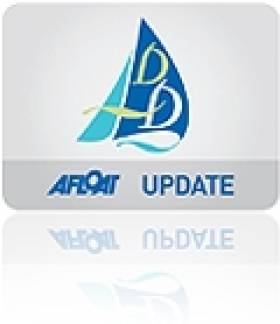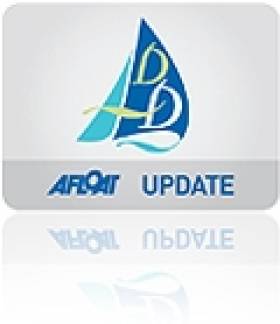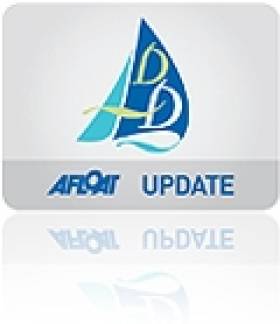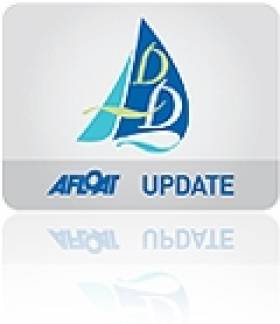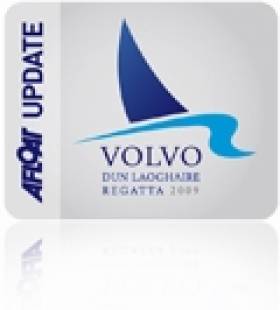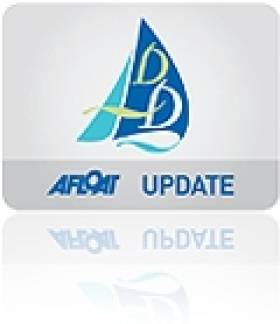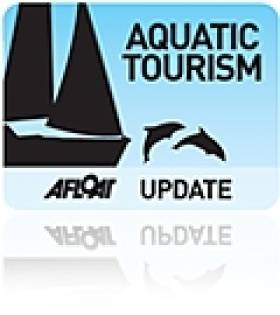Displaying items by tag: Dingle
Overall Results for the 2011 Dun Laoghaire to Dingle Race
| Yacht name | Skipper | Club | ||
|---|---|---|---|---|
| Two-Handed | 1st | Dinah | Barry Hurley | RIYC |
| Cruiser Class | 1st | Spindrift | David Kelly | Wicklow Hbr SC |
| 2nd | Yahtzee | Richard Mossop | Calafort Sea Scouts | |
| 3rd | Persistance | Jerry Collins | RStGYC | |
| Ocean Blue | Frank Cassidy | NYC | ||
| Mojito | Peter Dunlop | Pwlhelli SC | ||
| Racing Class | 1st | Galway Harbour | Martin Breen | Galway Bay SC |
| 2nd | Raging Bull | Matthew Davis | Skerries SC | |
| 3rd | Tsunami | Peter Ryan | NYC | |
| Aquelina | James Tyrrell | Arklow SC | ||
| Jedi | Andrew Sarratt | RStGYC/RIYC | ||
| Sailing West Intuition | Paul Adamson | NYC | ||
| Sgrech | Stephen Tudor | Pwlhelli SC | ||
| Legally Brunette | Cathal Drohan | RStGYC | ||
| English Mick | Carol Payne | Poolbeg Y&BC | ||
| Pride of Dalkey Fuji | Alam McGettigan | RIYC | ||
| Lula Belle | Liam Coyne | NYC | ||
Galway Harbour Claims Dun Laoghaire to Dingle Race
From an early decision just after the start not to get sucked inshore, Galway Harbour led the race on handicap almost from start to finish. But even more remarkably, they led on the water for much of the race and only conceded the on-the-water lead to the top rated boat, keeping the other 8 higher rated boats well astern.
Coping with blown out sails, low visibility, a damaged vang, gale force winds with beam seas, no main for two hours and considerable sleep deprivation was swallowed up in their stride to the finish, pushing particularly hard in the final stage along the west Cork and Kerry coasts.
Lynx, for that is the yacht’s original name, was built originally for Sir Robin Knox Johnston’s Clipper Venture corporate training fleet. More recently she has racked up some successes as an IRC racer and underwent a complete refit in 2009. Skipper Martin Breen put together a formidable crew for the race and their mixed offshore and dinghy sailing experience combined successfully to take the overall prize.
Galway Harbour Crew: Martin Breen – Helm, Neil Spain - Helm 2, Aodhán Fitzgearld - W/L Navigator, John Murphy - W/L Tactician (Trim), Nigel Moss - Main Trimmer, Conor Baynes - Jib/ Kite (Main) Trimmer, Brian Phelan - Jib/ Kite Trimmer , Rachel O'Toole - Pit (Trim), Ruaidhrí De Faoite - Mast (Trim), Cathal Clarke - Bow (Trim)
Galway Harbour Approaches Dingle Finish
Galway Harbour has been brilliantly sailed, with Neil Spain backing up Martin Breen. Raging Bull has been there or thereabouts all race as has Aquelina. Legally Brunette could never quite get up to her handicap and Tsunami put in a bit of a spurt at the end. It's going to be very close between Raging Bull and Tsunami for second place. Too close to call. If Raging Bull finishes less than 1 hour 27 behind Tsunami she gets second.
At the moment it looks like the rest of the fleet are all also rans but we'll follow up with overalls later and see how it panned out.
Update: Pride of Dalkey Fuji Approaches the Fastnet
However, as the current weather system passes through, the veering wind should favour those closest inshore and Aquelina could make some gains prior to rounding the rock. That said, the crew of Galway Harbour haven't done much wrong so far and will be well aware of what they have to do to stay ahead.
While Pride of Dalkey Fuji looks set to take line honours, the battle is really on between Galway Harbour and Aquelina, with Dinah, Jedi and Orna fighting it out for the minor placings and Raging Bull losing our from her more offshore position.
History has shown that the race has sometimes been won and lost in the stretch between the Fastnet and Dingle and with the center of the system tracking just west of Dingle right now, an upset is a distinct possiblility.
From Brian Carlin onboard the Sigma 400, Raging Bull.
Location: 30 miles South East of The Fastnet
Time: 13:30
Right, not sure where to start, well we rounded Tuscar Rock at 10:30pm in a building sea, the 3G coverage disappeared and well after last night this has been my first opportunity to write anything.
A beautiful sunset started the evening but that was all that was nice about it. Grey dark clouds greeted out first night at sea, and it got cold on deck, sitting as the spray increasingly came across the decks.
Let's just say alot of the crew went quite and the great banter we had all day soon became a game of who was first to bed for some sleep and a dry area to stay..
It was 3am before I got below decks and our plan was to head south early while the winds allowed before the southerly direction forecast came into play.. it was a rough night with little sleep, main sail reefs in and then back out again trying to deal with the ever changing wind speed, which topped out at 26kts later that night, gusting 29knts.
When the morning broke I was back on deck, decision to say south was the plan, make the Fastnet lighthouse in one tack rather than beat up the coast, now we still don't know if this plan is going to pay, so we have an anxious wait until the rock to see if it worked.
We had the kite up for a while clocking speeds of 12knts , but a 2 foot tear in the mainsail slowed us up for 25mins as we repaired it.. It's fixed but not sure how long it will take this constant 20 knots right now...
Right I'm off to find some food as alot are taking the next couple of hours to rest before we make the big push north towards the Skelligs..
Dun Laoghaire to Dingle - First Leg Race Preview
This should advantage the smaller boats of the fleet initially, but could help the larger boats to get further along the south coast before the westerly sets in around midnight Sunday.
Alan McGettigan's Pride of Dalkey- Fuji should show a clean pair of heels to the fleet, but she will always be fighting the handicap and a slow start will not suit.
Expect to see quite a battle between 2009 winner Cathal Drohan's X41, Legally Brunette, the Tyrell J122 Aquelina and the relatively unknown Steve Kershaw's Fortuna Redux, the South African built Fast 42. ISORA class leading form has already been shown by Richard Tudor's Sgrech and Vincent Farrell's Tsunami, while Matt Davis' Sigma 400 Raging Bull is a recent winner.
While the handicap suggests that Pride of Dalkey-Fuji should take line honours, the current forecast suggest the overall winner will come from the lower rated boats.
Its going to be an interesting few days.
29 Enter Dun Laoghaire to Dingle Race
With less than a week to the start of the the Dun Laoghaire to Dingle Race 29 boats are entered for the 320-mile classic. 2009 race winner Legally Brunette is entered and there will be a two boat two handed match race. The final race entry list is below.
| Name of Boat | Sail No. | Model | IRC TCC | Sub Division | Name | |
|---|---|---|---|---|---|---|
| Spindrift | IRL 1503 | HR34 | White | Cruiser | David Kelly | |
| Dinah | IRL 3508 | JOD 35 | White | 1.016 | Two Handed | Barry Hurley |
| Powder Monkey | IRL 28892 | J109 | White | 1.028 | Racing | Chris Moore |
| Lula Belle | IRL 3607 | Beneteau 36.7 | White | 1.019 | Racing | Liam Coyne |
| Orna | IRL 532 | Grand Soleil 40C | Blue | 1.043 | Racing | Philip Dilworth |
| Aquelina | IRL 1281 | J122 | White | 1.088 | Racing | Sheila/James Tyrrell |
| Ocean Blue | IRL 1352 | Pacific Seacraft 40 | Cream | 0.936 | Cruiser | Francis Cassidy |
| Raging Bull | IRL 9666 | Sigma 400 | White | Racing | Matthew Davis | |
| Emir Herr | IRL 1118 | Beneteau 47.3 | Blue | 1.037 | Cruiser | Liam Shanahan |
| Something Else | IRL 29213 | J109 | Blue | 1.028 | Racing | John Hall |
| Premier Cru | IRL 1152 | Beneteau 50 | Blue | Cruiser | Alan Jackson | |
| Lisador | IRL 1295 | Dehler 36 | White | 0.959 | Racing | Henry Hogg |
| Jedi | IRL 8088 | J109 | White | 1.029 | Racing | Andrew Sarratt |
| Galway Harbour | GBR 7386R | Reflex 38 | White | 1.057 | Racing | Martin Breen |
| Betty Boop | IRL 285 | Puppeteer 330S | Blue/White | 0.911 | Racing | John Alvey |
| Tom Crean Brewery | GBR 2750 | SJ320 | Light Blue | 1.008 | Racing | Yannick Lemonnier |
| Mojito | GBR 1536L | Bavaria 39 | White | 0.988 | Cruiser | Peter Dunlop |
| Fortuna Redux | GBR 2568L | Fast 42 | White | Racing | Steve Kershaw | |
| Yahtzee | IRL 1068 | Beneteau 411 | White | 0.983 | Cruiser | Richard Mossop |
| English Mick | GBR 4771R | Beneteau 47.7 | Blue | Racing | Carol Payne | |
| Rebellion | IRL 6001 | Nicholson 58 | Blue | 1.059 | Cruiser | John Hughes |
| Tsunami | IRL 4007 | Beneteau 40.7 | Grey | 1.061 | Racing | Vincent Farrell |
| Sailing West Intuition | GBR 9383R | Reflex 38 | Blue | 1.057 | Racing | Paul Adamson |
| Sgrech | GBR 9319R | J109 | White | 1.021 | Racing | Stephen Tudor |
| Pride of Dalkey-Fuji | GBR 38 | Class 40 | Green | 1.251 | Racing | Alan McGettigan |
| Sunsari | IRL 3201 | Sunfast 32i | White | 0.945 | Two Handed | Tom Salter |
| Legally Brunette | IRL 4053 | X41 | White | 1.122 | Racing | Cathal P Doran |
| Persistance | GBR 8237T | Sigma 38 | White/Navy | 0.985 | Cruiser | Jerry Collins |
| Saxon Senator | IRL 1447 | X37 | Blue | 1.039 | Racing | Wanfred/Eric Watermam |
Eleven Races in Busy Irish Sea Offshore Schedule
Chairman of ISORA Peter Ryan sets out the 2011 programme for ISORA that kicks off on April 7th with an introductory evening on April 7th.
Spring has come and the days are getting longer. It is now time to be thinking about offshore racing again. The first race is on the 30th April from Dun Laoghaire to Holyhead.
I attach again the latest Race Schedule, Notice of Race, Conditions and Entry Form for 2011. I also attach details of the proposed "Offshore Introduction" night for offshore racing on the 7th April. Even if you are experienced, you can add to the proceedings or just come for the reception after.
There is an extensive list of eleven races in the schedule. The types of race vary greatly to give a variety of racing experiences. There are Day Races, Night Races, Short Cross Channel Races, Medium Cross Channel Races, 100 mile Lyver Trophy Race and "The Dingle Skellig Hotel D2D" – Dingle Race. There is racing for IRC, IRC No Spinnaker and 2-handed classes.
This season, if the number of entries permits, we will be running a Classic Class in both Class 1 & 2. The boats eligible for the Classic Classes will be selected by the Sailing Committee before the start of the first race and the selection will be based on the boats performance / capability during the previous season. It is hoped that this will provide a much greater spread of prizes. The rating break for Class 1 and Class 2 will be decided at the same time.
The Race schedule has been carefully selected to ensure the maximum amount of sailing and social life is obtained. The usual "get together" will take place before and after each race. This season we have some additional attractions:
If desired, the race on the 28th May from Pwllheli to Wicklow can be followed by boats taking part in the "Turbine Race" (see www.arklowsc.com on Sunday 29th. This race starts and finishes in Arklow, 10 miles from Wicklow. This will allow the usual "get together" in Wicklow on Saturday evening and another one in Arklow on Sunday after the Turbine Race. This is the UK Bank Holiday weekend and will allow the UK boats time to return home on Monday!
After taking part in the "Dingle Skellig Hotel D2D Dingle Race" on the 11th June. Please note that a second separate entry to the NYC is required if taking part in this race in the series. After a few relaxing nights in Dingle, you can wander around to take part in the "ICRA Championships" in Crosshaven before making your way to Kinsale for the "Sovereign's Cup". The Dingle Race is a qulaifier race for the Fastnet Race.
The Lyver Race on the 1st July is a Feeder Race to the Volvo Dun Laoghaire Regatta from the 7th-10th July – a great few days sailing in Dublin Bay. This race is a RORC qualifier for the Fastnet Race. Again, seperate entry is required for the Liverpool Yacht Club sections of the event.
The Sunday Race on the 14th August will take place directly after the start of the Solitaire du Figaro fleet from Dun Laoghaire. If possible we will set a course to follow the fleet down the coast. For visiting boats to Dun Laoghaire, the Figaro fleet will arrive in Dun Laoghaire on the Wednesday 10th August and there will be a festival in Dun Laoghaire for the couple of days to celebrate the event. There will be great craic in Dun Laoghaire for those days.
You may not have noticed but the ISORA website www.isora.org has been upgraded and will become very active this year. There is a "Crew Register" and a "Buy and Sell" section in the "Forum" page. I would encourage everyone to register for this facility and use it to get crew for races or for crew to get boats. Try the website out.
The "ISORA Introductory Evening" in the NYC on the 7th April. The purpose of this is to encourage those boats who are thinking of taking part in Offshore Racing by a series of talks about what is involved in this type of racing. I will also use this session to demonstrate the use of the new website's "Crew Register". I also hope to issue detailed instructions by email on the use of this facility. The session will be followed by a reception where people can solialise and relax. "Prof" O'Connell and Mick Liddy will be talking at the event. I will also be encouraging participation from the audience. It will be a great night so please come and bring a friend.
I look forward to receiving your entries very soon. I would appreciate it if you could also spread the good news about ISORA and Offshore Racing.
Afloat's March/April Issue Out Next Week!
Is there no end to the achievements of Irish boaters against seemingly impossible odds?
The winter may have been a time of hibernation for some of us but as the stories in Afloat's March/April issue will bear out Irish sailors have been battling the elements all winter long.
James Carroll competed in January's Sydney-Hobart offshore race and, much closer to home, Paul A. Kay journeyed through snow and ice in December from Dun Laoghaire to a new marina on Valentia Island.
As if to prove a point that we're down but not out, a winter of results on foreign waters includes a win in the Mirror World Championships in Australia and a top Olympic result in Florida, USA.
They are gutsy performances from youth teams that shows, if nothing else, the next generation of Irish sailors is really up for a fight. All this plus lots, lots more on news-stands next week!
Selected contents from Ireland's only boating magazine include:
News
Surveyors Issue Boat Launch Warning, Buoyant Dinghies Buck the Market, Ice Diving in Ireland, German U-Boat Rediscovered in Cork Harbour, an Historic Trophy for South Pacific Dream Cruise, MGM open in Cork, Hugh Mockler joins Crosshaven Boatyard plus lots, lots more.
News Focus
A new masterplan for Dun Laoghaire harbour is badly needed but it needs buy in from all those that use it
Going Offshore
The tenth Dun Laoghaire to Dingle offshore race was launched in style
Marine Conference
Combating the downturn was the focus of a unique marine gathering on both sides of the Irish sea.

Gear Review
New dinghy gear, a new Crosshaven boot from Dubarry, a new raincoat for girls and an upgrade for Musto's MPX.

This Island Nation
The decision to shut down the fog signals was based on a detailed risk assessment. Tom MacSweeney on the loss of fog horns
Sailor of the Year
Anthony O'Leary of Cork is the Afloat.ie/Irish Independent "Sailor of the Year" in celebration of his outstanding achievements afloat nationally and internationally.
Tall Ships
W M Nixon looks at the realities of national sail training in the 21st Century.
Tall Ship Conference
Ireland could yet have a tall ship to replace the Asgard II and the Lord Rank, if a new group formed to press for a replacement is successful
Racing update
Ulstermen's World Title, Topper worlds for Dun Laoghaire, Two Irish campaigns line up for Figaro Race, SB3 Sailors Cry Foul at Dun Laoghaire Parking Fees and an Irish entry in the Moth worlds in Australia, Irish Mini 6.50 Campaign in Prospect.

Youth Worlds preview
Results achieved abroad this Winter are the backbone for further Irish youth
success

Figaro Preview
Two fledgling Irish La Solitaire du Figaro campaigns edged closer to the start line last month
Volvo Dun Laoghaire Regatta
Volvo Dun Laoghaire regatta has taken in 22 entries six months ahead of the first race of the biggest regatta in Irish sailing.

Fireball Worlds preview
Dun Laoghaire's Noel Butler intends to continue his winning run in the Fireball class this season but the year ahead doesn't look so easy as the World Championships come to Sligo
Sovereigns cup preview
Up to 30 Quarter tonners will be at the Sovereigns Cup this year including one from New Zealand.
Shiver to deliver
A journey through snow and ice from Dun Laoghaire to Valentia Island
Sydney-Hobart Race
Outside of the Volvo Ocean Race, the Sydney Hobart is one of the world's most challenging offshore races. James Carroll Raced it in January.
Inland
As the cuts begin to bite, it may be time to look at the British direction for our waterways, writes Brian J Goggin
Dubarry Nautical Crossword
Soundings
A Google aerial photo proves useful navigating for Baldoyle Estuary
- Anthony O'Leary
- Dun Laoghaire
- Tom MacSweeney
- Harbour
- MGM Boats
- Asgard II
- World Championships
- Dinghies
- Olympic
- Cork Harbour
- Valentia
- Mirror
- Dingle
- youth
- Lord Rank
- Island Nation
- Hugh Mockler
- Dubarry
- Tall ship
- brokerage
- sydneyhobart
- fog horn
- moth
- Mini 6.50
- Uboat
- Fireball worlds
- Sovereigns
- James Carroll
- Paul A. Kay
- Crosshaven Boatyard
- Baldoyle
- MPX
- W M Nixon
Dun Laoghaire to Dingle Race 2011 is Launched
The possibility of an Open 40 entry plus a new white sail division are just some of the developments for the tenth Dingle Skellig Hotel Dun Laoghaire to Dingle Race. Over 50 (SCROLL DOWN FOR PHOTOS BY MICHAEL CHESTER) gathered at the National YC in Dun Laoghaire last night to hear local TD and the Minister for Sport, Tourism and Culture Mary Hanafin give a ringing endorsement for the unique 320-mile offshore race when it sets sail on June 11th. A notice of race and entry form is available for download below.
The last race attracted 39 entries and a course record was set by Michael Cotter's Whisper. This year organisers Martin Crotty and Brian Barry along with Dingle Harbour master Brian Farrell are confident that they will break the 40 boat barrier. They may well be right as the event has been specifically timed to bring Dublin boats to the south coast for ten days of racing at the ICRA Nationals in Cork Harbour and the Sovereigns Cup the following week in Kinsale.
The event is also benefitting from inclusion in this year's ISORA calendar.
Present last night were represntatives from the major Bay clubs, including Breda Dillon from Howth YC and Fintan Cains of ICRA. Peter Ryan of ISORA, who is also the National YC commodore spoke about plans to develop off shore sailing and the club's plans to welcome the international Figaro offshore fleet in August.
Solo sailor Mick Lidddy who is making a bid for an Irish entry into the race was also in attendance.
SCROLL DOWN FOR LAUNCH PHOTOS BY MICHAEL CHESTER
Afloat coverage of the 2009 Race is HERE
Capital Grant for Dingle Aquarium
The funding will be used to develop a polar penguin exhibition centre. The new facility, which is adjacent to the existing aquarium, will be able to house up to ten penguins in a temperature-controlled environment, to replicate Antarctic conditions. The project is to expected to start shortly and the centre is anticipated to open to the public by Easter 2011.
Since opening in 1996, Oceanworld has attracted 100,000 each year. The company employs a staff of five-full time and 16 part-time staff. As a result of the development, an added three jobs are expected for the new exhibition centre.
The aquarium's website can be found at www.dingle-oceanworld.ie/




























